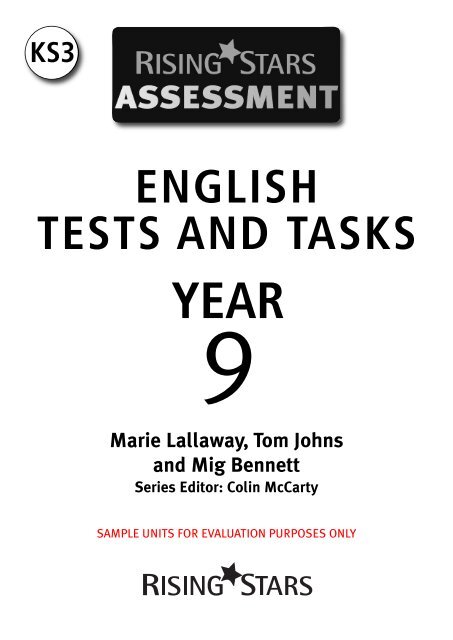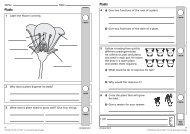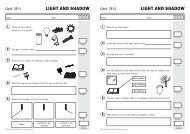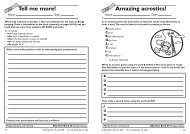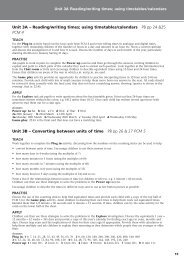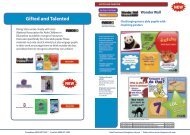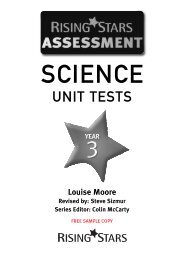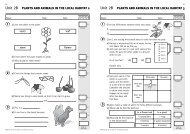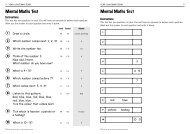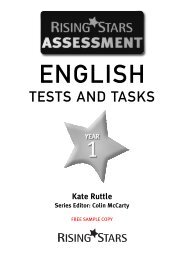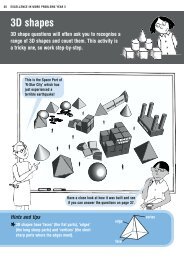Reading Test 1 - Rising Stars
Reading Test 1 - Rising Stars
Reading Test 1 - Rising Stars
Create successful ePaper yourself
Turn your PDF publications into a flip-book with our unique Google optimized e-Paper software.
KS3ENGLISHTESTS AND TASKSYEAR9Marie Lallaway, Tom Johnsand Mig BennettSeries Editor: Colin McCartySAMPLE UNITS FOR EVALUATION PURPOSES ONLY
Quick start guide to <strong>Rising</strong> <strong>Stars</strong> AssessmentStep 1 Introduce the testsThe tests are linked to the genres and text types recommended by therenewed Framework for Secondary English.Explain to the class that they will take one reading test and two writingtasks each term. This will give them the opportunity to show theirprogress in reading and writing fiction and non-fiction againstaseessment focuses. Results can be used to record and monitor progressthroughout the year.At the end of each term, photocopy the test and give it to the class tocomplete.More information about using the tests is given on pages 6-7.This extract is from a story written in 1897. The narrator is staying at the castle of a man namedthe Count – who turns out to be a rather strange man. The narrator has just spent his first night atthe castle and wakes up.The PrisonerI only slept a few hours when I went to bed, and feeling that I could not sleep any more,got up. I had hung my shaving glass by the window, and was just beginning to shave.Suddenly I felt a hand on my shoulder, and heard the Count's voice saying to me, ‘Goodmorning.’ I started, for it amazed me that I had not seen him, since the reflection of theglass covered the whole room behind me. In starting I had cut myself slightly, but did notnotice it at the moment. Having answered the Count's salutation, I turned to the glassagain to see how I had been mistaken. This time there could be no error, for the man wasclose to me, and I could see him over my shoulder. But there was no reflection of him inthe mirror! The whole room behind me was displayed, but there was no sign of a man init, except myself.This was startling, and coming on the top of so many strange things, was beginning toincrease that vague feeling of uneasiness which I always have when the Count is near. Butat that instant I saw that the cut had bled a little, and the blood was trickling over mychin. I laid down the razor, turning as I did so half round to look for some stickingplaster. When the Count saw my face, his eyes blazed with a sort of demoniac fury, and hesuddenly made a grab at my throat. I drew away and his hand touched the string of beadswhich held the crucifix. It made an instant change in him, for the fury passed so quicklythat I could hardly believe that it was ever there.‘Take care,’ he said, ‘take care how you cut yourself. It is more dangerous that you think inthis country.’ Then, seizing the shaving glass, he went on, ‘And this is the wretched thingthat has done the mischief. It is a foul bauble of man's vanity. Away with it!’ And openingthe window with one wrench of his terrible hand, he flung out the glass, which wasshattered into a thousand pieces on the stones of the courtyard far below. Then hewithdrew without a word. It is very annoying, for I do not see how I am to shave, unless inmy watch-case or the bottom of the shaving pot, which is fortunately of metal.When I went into the dining room, breakfast was prepared, but I could not find the Countanywhere. So I breakfasted alone. It is strange that as yet I have not seen the Count eat ordrink. He must be a very peculiar man! After breakfast I did a little exploring in thecastle. I went out on the stairs, and found a room looking towards the South.The view was magnificent, and from where I stood there was every opportunity of seeingit. The castle is on the very edge of a terrific precipice. A stone falling from the windowwould fall a thousand feet without touching anything! As far as the eye can reach is a seaof green tree tops, with occasionally a deep rift where there is a chasm. Here and thereare silver threads where the rivers wind in deep gorges through the forests.But I am not in heart to describe beauty, for when I had seen the view I explored further.Doors, doors, doors everywhere, and all locked and bolted. In no place save from thewindows in the castle walls is there an available exit. The castle is a veritable prison, and Iam a prisoner!2© <strong>Rising</strong> <strong>Stars</strong> UK Ltd 2008. You may photocopy this page. 11Step 2 Mark the test<strong>Test</strong>s and tasks can be marked by the teacher, or by the student.Students may assess their own work or swap tests and mark anotherstudent’s test.Use the mark scheme and your own professional judgement to awardmarks. Do not award half marks.We suggest you annotate the mark grid for the writing task with a tickto indicate the bullet points for which you are awarding credit. Circle orwrite the mark you are giving.Answers and mark schemes for reading testsFear<strong>Reading</strong> <strong>Test</strong> 1: The PrisonerQ Answer and marking guidance Mk AF Lvl Extra information1 • touch on shoulder1 3 5 1 mark for all correct• voice• no reflection of the man in mirror/glass2 … which I always have (when the Count is near) 1 3 53 blazed – creates association with fire (raging)/lit up like 1 5 6flamesdemoniac – creates associations with devil-like/nonhuman/evil1 74 What happens5 6 4 1 mark for simple, generalised• sudden appearance and lack of a reflectionand/or brief comments relating• sudden changes in behaviourto each heading• warning about cutting self5 2 or 3 marks for answers which• hand throwing mirrorsupport a general comment• not eating or drinkingwith three or four details fromthe narrator’s thoughtsthe suggestions and which• feeling of unease/exclamationsaddress both of the headings in• remembrances of other eventsdoing so• unusual acceptance of strangeness from narrator6–7 4 or 5 marks for answers whichrefer to a full range of detailfrom both lists and refer closelyto the text5 any two from:1 4 6• first engages reader into the narrative1 7• puts the drama into a beautiful/dramatic setting• balances need to escape with the impossibility of escape• emphasises that he (the narrator) is trapped• adds to conventional Gothic image53Step 3 Generate a levelThis is a good opportunity for peer assessment. Use the mark and levelthreshold tables to convert the student’s mark to a sub-level. The finalrow in each table gives an overall sub-level for each term’s tests. If youhave the CD-ROM version of KS3 English <strong>Test</strong>s and Tasks you can use theinteractive Level Calculator to convert marks to levels automatically.The mark and level threshold pages also include a summary of thedistribution of marks and levels for each test.The marks and level thresholds for Year 9<strong>Reading</strong> testsBalance of marks and levels in each reading test:NC level <strong>Test</strong> 1 <strong>Test</strong> 2 <strong>Test</strong> 34 2 0 05 8 8 86 12 15 177 10 9 12Total 32 32 32Mark ranges and level thresholds<strong>Reading</strong> <strong>Test</strong> 13a 4c 4b 4a 5c 5b 5a 6c 6b 6a 7c 7b 7a4 5–6 7–8 9–10 11–12 13–15 16–18 19–20 21–22 23–25 26–27 28–29 30–32<strong>Reading</strong> <strong>Test</strong> 23a 4c 4b 4a 5c 5b 5a 6c 6b 6a 7c 7b 7a3–4 5–6 7–8 9–10 11–12 13–15 16–18 19–20 21–22 23–25 26–27 28–30 31–32<strong>Reading</strong> <strong>Test</strong> 33a 4c 4b 4a 5c 5b 5a 6c 6b 6a 7c 7b 7a2 3 4–5 6–7 8–9 10–12 13–15 16–17 18–20 21–23 24–25 26–28 29–32Combined reading tests for Year 85c 5b 5a 6c 6b 3a 4c 4b 4a 6a 7c 7b 7a9–11 12–17 18–23 24–29 30–37 38–45 46–53 54–60 61–67 68–75 76–82 83–89 90–96Step 4 Feed back to the studentsUse a five-minute session with students to talk through the test and74give them the opportunity to make their own corrections. Identifystrengths and weaknesses and agree targets for learning.Encourage students to complete the diagnostic profile for reading and self-assessment sheets forwriting after each test or task. Students can keep these sheets and use them to record their progressthroughout the year.
FearFear affects everyone at some point. In these texts the reader canenjoy the fear presented in the story, and admire the explorers inthe news article for coping with a frightening experience.In the third text, the writer suggests how we all can deal withour own fears.1<strong>Rising</strong> <strong>Stars</strong> UK Ltd 2008. You may photocopy this page.©
This magazine article aims to help readers to deal with fear and lead happier lives.Don’t Let Fear WinHow much effort do we spend worrying about things that never happen? And moreimportantly, does that worrying stop us from doing things?My grandmother used to say that she had worried about a lot of troubles in her life,most of which never happened. Most of our fear is only in our minds.Fear of failure is one of the greatest fears people have. What if we fail? What if wemake a mistake? Will we be criticised? Will we look foolish?It took Thomas Edison more than 10,000 failed attempts to discover the tungstenfilament that worked in the incandescent light bulb. A reporter asked him how hemanaged to go on working in the face of so many failures. Edison’s reply was thateach failure gave him hope; every time he failed, he knew he was one step closer tofinding the answer. Edison believed that ‘many of life’s failures are people who did notrealise how close they were to success when they gave up.’Successful people, like Edison, overcome this fear. They try again. They make moremistakes but they learn from them. Fear of failure doesn’t cripple them. Unsuccessfulpeople let their fears rule. They talk about what they will do next but actually they putoff trying again. Why? Because they might fail again. So they give up.Remember learning to ridea bicycle? Or learning toswim? No one expected todo it right the first time.From the start we expectedto try, try and try again. Ifwe can believe that anystep in life is a lesson to belearned about futuresuccess, we prepareourselves, not to fail, but topractise, and then tosucceed.We need to relax in the face of fear of failure and ask ourselves what’s the worst thatcould happen? Would we still have options? Would everything be lost? You can chooseto face your fears or listen to that negative voice and miss out on your lifelongdreams. The choice is yours …4<strong>Rising</strong> <strong>Stars</strong> UK Ltd 2008. You may photocopy this page.©
<strong>Reading</strong> <strong>Test</strong> 1: Don’t Let Fear WinName: Class: Date: ☺☹12Why does the writer refer to learning from her grandmother and fromThomas Edison in this text?WhoWhyAF62 marks12a. grandmotherb. Thomas Edison13Remember learning to ride a bicycle? Or learning to swim?What is the effect on the reader of these rhetorical questions inparagraph 6?AF51 mark1318© <strong>Rising</strong> <strong>Stars</strong> UK Ltd 2008. You may photocopy this page. Total forthis page
<strong>Reading</strong> <strong>Test</strong> 1: Don’t Let Fear Win14How does each final sentence relate to the rest of the paragraph it is in?Draw lines to show the correct answers. One has been done for you.AF43 marks14Paragraph 2Most of our fear isonly in our minds.Summary of the rest of theparagraphParagraph 5So they give up.Explanation following examples inthe paragraphParagraph 6If we can believe thatany step in life is alesson to be learnedabout future success,we prepare ourselves,not to fail, but topractise, and then tosucceed.Consequence of actions within theparagraphParagraph 7The choice is yours …Invitation to think about theinformation in relation toourselves© <strong>Rising</strong> <strong>Stars</strong> UK Ltd 2008. You may photocopy this page. 19/32Total forthis test
<strong>Reading</strong> <strong>Test</strong> 1: Don’t Let Fear WinQ Answer and marking guidance Mk AF Lvl Extra information12 grandmother: familiar/general exampleThomas Edison: famous/detailed example116 6713 generally familiar experiences to make identifiable link forreader1 5 614 1Paragraph 2Summary of the rest of1Most of our fear is onlythe paragraph1in our minds.4 567Paragraph 5So they give up.Explanation followingexamples in theparagraphParagraph 6If we can believe thatany step in life is alesson to be learnedabout future success,we prepare ourselves,not to fail, but topractise, and then tosucceed.Consequence of actionswithin the paragraphParagraph 7The choice is yours …Invitation to thinkabout the informationin relation to ourselves55
Composition and effect• Some awareness of critical purpose evident in selection of relevant material, though content maybe limited or purely descriptive.• Simple viewpoint conveyed, though may lose sight of purpose.• Shows awareness of appropriate style for a review, e.g. through vocabulary choice.• Appropriate form is mostly maintained.• Viewpoint is generally consistent.• Vocabulary supports expression of review, e.g. the best thing is …Short Writing Task 1: Visit Garinto Today!Sentence structure and text organisationLevel• Simple connectives, such as and, but, so, link clauses.• Simple expansion of nouns and verbs adds limited detail, e.g. lovely town, walk slowly.• Within sections or paragraphs, some attempt to maintain links between ideas.• Sentences generally correctly demarcated. Some attempt to use other punctuation.3• Sentences are mostly grammatically sound.• Some use of subordinating connectives, e.g. when, if, because.• Some variation of subjects of sentences, e.g. this town, it, I.• Some expansion of nouns, e.g. lots of space, beautiful river.• Some variation between present and future tenses, e.g. countryside is rocky, you will see.• Within sections or paragraphs, content organised around a main idea or topic sentence.• Accurate use of full stops and some use of commas to mark clauses.4• Compound and complex sentences are used, including connectives, such as although, however.• Noun phrases add detail, e.g. largest mountain in the area.• Modals used for recommendation and suggestion, e.g. must visit, everyone should.• Within sections or paragraphs, main ideas developed by example or detail.• Almost all sentences correctly demarcated. Correct use of commas for non-embedded clauses.5• A range of grammatical structures is used to vary sentences, e.g. foregrounding connectives, suchas even though …, and fronted adverbials.• Relative clauses expand detail and noun phrases are used concisely, e.g. the town square, whichis …• Within paragraphs, ideas linked or sequenced by a range of devices.• A range of punctuation used for clarity, e.g. dashes, parentheses, ellipses.6• Appropriate form, including description and recommendation, is maintained.• Viewpoint is consistently controlled.• Vocabulary is precise and varied, e.g. My favourite moment is ...Mark schemes for writing tasks• A range of sentence structures used to maintain audience interest in the review.• Controlled placing of adverbials and expanded noun phrases gives concision, e.g. wander free andundisturbed, the perfect weekend away location.• Variety of verb forms, different tenses and modals add interest to the advice, e.g. never, sincethen, have I found ...• Within paragraphs, a range of devices supports links between ideas, e.g. connectives, generalising,summarising.• Range of punctuation used to clarify meaning and create particular effects.7• Review engages interest through well-selected and expressed content.• Viewpoint is well-controlled, and refers to viewpoints of others.• Stylistic features, such as contrast and exaggeration, are used for effect.• Purpose of task fulfilled, e.g. by adoption of varied tone in review to engage the reader.• Viewpoint acknowledges and addresses possible interests of reader.• Appropriate and individual style used to convey viewpoint and chosen approach.<strong>Rising</strong> <strong>Stars</strong> UK Ltd 2008. You may photocopy this page.©
Spelling – generic mark guidanceAssessment focus 8: use correct spellingUse the following marking guidance to mark spelling in the Short Writing Tasks.MarksavailableMain criterion: the spelling of simple and common polysyllabic words is usually accurate.1Likely patterns of error:• There may be some confusion of more complex homphones, e.g. course/coarse,breaking/braking and phoneme omission, e.g. rem[em]ber;• There may be errors in using suffixes and prefixes, e.g. tryed, familys, dissappear,hoping/hopeing/hopping.Main criterion: the spelling of words with complex regular patterns is usually accurate.2Likely patterns of error:• There may be incorrect hyphenation of some compound words, e.g. re-act, grand-father;• There may be errors in more complex suffix formations, e.g. responsable, physicly, basicly.Main criterion: most spelling, including that of irregular words, is usually correct.3Likely patterns of error:• Errors may occur with unstressed vowels, e.g. dependant, definatly or with consonantdoubling in some more complex words, e.g. embarrasement, occassionally, adress.Main criterion: virtually all spelling, including that of complex irregular words, is correct. Anyerrors stand out as untypical or one-off slips.4A response which does not fulfil the criteria for 1 mark for spelling should be awarded 0.<strong>Rising</strong> <strong>Stars</strong> UK Ltd 2008. You may photocopy this page.©
The marks and level thresholds for Year 9<strong>Reading</strong> testsBalance of marks and levels in each reading test:NC level <strong>Test</strong> 1 <strong>Test</strong> 2 <strong>Test</strong> 34 2 0 05 8 8 36 12 15 177 10 9 12Total 32 32 32Mark ranges and level thresholds<strong>Reading</strong> <strong>Test</strong> 1: Fear3a 4c 4b 4a 5c 5b 5a 6c 6b 6a 7c 7b 7a4 5–6 7–8 9–10 11–12 13–15 16–18 19–20 21–22 23–25 26–27 28–29 30–32<strong>Reading</strong> <strong>Test</strong> 2: Life on Wheels3a 4c 4b 4a 5c 5b 5a 6c 6b 6a 7c 7b 7a3–4 5–6 7–8 9–10 11–12 13–15 16–18 19–20 21–22 23–25 26–27 28–30 31–32<strong>Reading</strong> <strong>Test</strong> 3: Secrets of the Amazon3a 4c 4b 4a 5c 5b 5a 6c 6b 6a 7c 7b 7a2 3 4–5 6–7 8–9 10–12 13–15 16–17 18–20 21–23 24–25 26–28 29–32Combined reading tests for Year 83a 4c 4b 4a 5c 5b 5a 6c 6b 6a 7c 7b 7a9–11 12–17 18–23 24–29 30–37 38–45 46–53 54–60 61–67 68 –75 76–82 83–89 90–96
Reliability and predictions<strong>Reading</strong> testsAll good reading tests should be a fair experience for each student; with some questions being easy,some quite challenging and some hard. This makes the reading assessment a valid experience,enabling the student to show progress in reading and writing both fiction and non-fiction. The testmust also cover what has been taught. The questions in the <strong>Rising</strong> <strong>Stars</strong> tests assess across the rangeof assessment focuses for reading, at a level which is appropriate for the target age group. In aproperly designed and balanced test, it is possible to work out a set of theoretical pass markthresholds and these are discussed below. Theory and practice must come together, however, and the<strong>Rising</strong> <strong>Stars</strong> tests need to be standardised and linked to the National Curriculum levels established byQCA in order for the levels to be reliable and valid. These equated sub-levels are given on page 73.Writing tasksIn the writing tasks, the challenges are chosen to be suitable for the age and experience of the pupil.We believe it helps for the writing tasks to be taken after the reading test as this gives backgroundand pointers to assist students in their own writing. The writing tasks should enable students todemonstrate what they have learned against the criteria of the writing assessment focuses, thusenabling them to achieve appropriate levels in the tests. The writing tasks also provide opportunitiesto assess spelling and therefore mirror the optional and KS3 tests from QCA.Standardising the tests<strong>Rising</strong> <strong>Stars</strong> conducted research with three schools in April, May and June 2008. Students sat anumber of the reading tests, appropriate for each term of their year. The scores students obtainedwere then equated to reading levels obtained from the 2007 QCA KS2 reading test for Year 7 and the2008 QCA KS3 reading test for Year 9.The table below summarises the number of students in the sample.Year 7 8 9Actual sample analysed 220 0 221Original sample taking part 330 420 350Teachers and students in the schools also commented on the language, illustrations and suitability ofthe questions in the tests. A number of the questions were refined and improved thanks to this advice.The equating data for the reading testsA series of equating exercises were undertaken to link the levels and scores obtained for the Year 7and Year 9 <strong>Rising</strong> <strong>Stars</strong> reading tests to QCA levels. This was done by an independent specialist usingthe same methodology used to equate National Curriculum tests from one year to the next in thedevelopment of QCA’s tests. A review of the equating data enabled the algorithm, which converts amark to a level, to be modified slightly to ensure the <strong>Rising</strong> <strong>Stars</strong> tests more closely reflect QCA levels.See the Appendix for further information.
YEAR 9/RELIABILITY AND PREDICTIONSDevelopment of tests – technical informationA level has been ascribed to every mark so that the tests can be seen from the outset to be balanced,covering an appropriate span of levels for the year group in question.The equating data was used to provide an empirical model that would enable <strong>Rising</strong> <strong>Stars</strong>theoretically-generated sets of thresholds to be informed by the equated ones. We could then see howthe tests compare in terms of level of demand to the Key Stage 2 reading test in Year 7 and the KS3reading test in Year 9. The same algorithm was used for Year 8, having first been confirmed by theYear 9 research data.• Questions at their working level – students get correct 60% of the marks available;• Questions at one level below their working level – students get correct 80% of the marksavailable;• Questions at two levels below their working level – students get correct all of the marksavailable;• Questions at one level above their working level – students are able to get correct 30% of themarks available (40% in Year 7);• Questions at two levels above their working level – students are able to get correct 10% of themarks available.Overall, we find that <strong>Rising</strong> <strong>Stars</strong> tests, by design, are quite similar and as challenging as QCA tests.The writing tasks, however, are more supported for weaker students through wider use of ‘planningsheets’. The equating process makes sure that the sub-levels we report for reading match to the KeyStage reading levels. Feedback from our research schools and users of <strong>Rising</strong> <strong>Stars</strong> tests over the pastyears indicates that challenging tests, requiring written answers, taken throughout the year improvestudents’ performance more than tests that are too easy.Appendix<strong>Reading</strong> test equipercentile relationship to QCA levelsIn the trialling process, the <strong>Rising</strong> <strong>Stars</strong> levels were very close to, but not completely in line with, QCAlevels. This is shown by the equipercentile graphs, which do not overlap at all points. In order toimprove the match with QCA levels, the <strong>Rising</strong> <strong>Stars</strong> algorithms were adjusted so that the thresholdsquoted on page 74 match closely with the end-of-year QCA levels for Years 7, 9 and 8.Cumulative %1009080706050403020100Year 7Equipercentile equating graphs1 2 3 4 5 6MarksKey: QCA Level RS2 LevelThe y axis shows the cumulative percentage of students gaining levels.Cumulative %1009080706050403020100Year 9Equipercentile equating graphs1 2 3 4 5 6MarksKey: QCA Level RS2 Level


